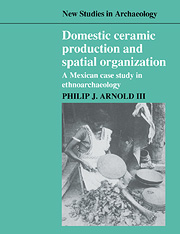Book contents
- Frontmatter
- Contents
- List of figures
- List of tables
- Acknowledgements
- 1 Introduction
- Part 1 Ceramic production and consumption in Los Tuxtlas
- Part 2 Ceramic production and spatial organization
- 5 Archaeological approaches to ceramic production
- 6 Spatial organization and ceramic production
- 7 Disposal patterns within production houselots
- Part 3 Application and implication
- References
- Index
5 - Archaeological approaches to ceramic production
Published online by Cambridge University Press: 02 December 2009
- Frontmatter
- Contents
- List of figures
- List of tables
- Acknowledgements
- 1 Introduction
- Part 1 Ceramic production and consumption in Los Tuxtlas
- Part 2 Ceramic production and spatial organization
- 5 Archaeological approaches to ceramic production
- 6 Spatial organization and ceramic production
- 7 Disposal patterns within production houselots
- Part 3 Application and implication
- References
- Index
Summary
The preceding section has placed the Tuxtlas potters in an ecological context. Information on the producer environment, coupled with data on pottery production and consumption, has exposed the dynamic nature of production-related activities. It is now time to consider how such a system might be approached from an archaeological perspective.
This chapter explores some of the fundamental issues involved in the identification and interpretation of pottery production. The first section considers how archaeologists establish the existence of production areas. Both epistemological and empirical issues are raised. This discussion argues that confusion in these two arenas presently hampers our inferential approach to ceramic production. Through an examination of these issues the stage is set for addressing models of production organization.
The second section focuses on these models and critically evaluates their utility. These approaches are shown to be overly static with only a limited applicability to many archaeological goals. This discussion underscores the need for a more rigorous approach to investigating production activities.
A frame of reference
After many years studying ceramics at the regional and inter-regional level, Mesoamerican archaeologists have recently begun investigating the actual location of ceramic production activities. This new emphasis on “microprovenience” studies (Rice 1981:219) is an outgrowth of research questions that seek a more detailed understanding of the producer's socioeconomic environment (e.g. Deal 1988:113; Feinman 1985; Santley et al. 1989; Stark 1985:158–160). Research into the scale of a production system is conducted more effectively when the actual production entities can be identified and their characteristics evaluated.
- Type
- Chapter
- Information
- Domestic Ceramic Production and Spatial OrganizationA Mexican Case Study in Ethnoarchaeology, pp. 83 - 98Publisher: Cambridge University PressPrint publication year: 1991



